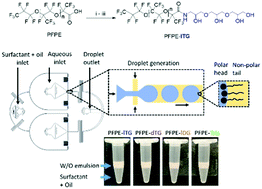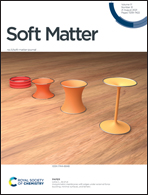Linear triglycerol-based fluorosurfactants show high potential for droplet-microfluidics-based biochemical assays†
Abstract
Fluorosurfactants have expanded the landscape of high-value biochemical assays in microfluidic droplets, but little is known about how the spatial geometries and polarity of the head group contribute to the performance of fluorosurfactants. To decouple this, we design, synthesize, and characterize two linear and two dendritic glycerol- or tris-based surfactants with a common perfluoropolyether tail. To reveal the influence of spatial geometry, we choose inter-droplet cargo transport as a stringent test case. Using surfactants with linear di- and triglycerol, we show that the inter-droplet cargo transport is minimal compared with their dendritic counterparts. When we encapsulated a less-leaky sodium fluorescent dye into the droplets, quantitatively, we find that the mean fluorescence intensity of the PFPE-dTG stabilized PBS-only droplets after 72 h was ∼3 times that of the signal detected in PBS-only droplets stabilized by PFPE-lTG. We also demonstrate that the post-functionalization of PFPE-lTG having a linear geometry and four hydroxy groups enables the ‘from-Droplet’ fishing of the biotin–streptavidin protein complex without the trade-off between fishing efficiency and droplet stability. Thus, our approach to design user-friendly surfactants reveals the aspects of spatial geometry and facile tunability of the polar head groups that have not been captured or exploited before.

- This article is part of the themed collection: Soft Matter Most Popular 2021


 Please wait while we load your content...
Please wait while we load your content...